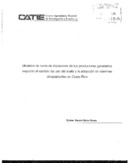| dc.contributor.author | Maza Rojas, Byron V. | |
| dc.date.accessioned | 2014-10-20T04:30:22Z | |
| dc.date.available | 2014-10-20T04:30:22Z | |
| dc.date.issued | 2004 | es_ES |
| dc.identifier | 366627 | es_ES |
| dc.identifier.uri | https://repositorio.catie.ac.cr/handle/11554/4721 | |
| dc.description | Tesis (Mag. Sc.) -- CATIE, 2004 | es_ES |
| dc.description | 86 páginas | |
| dc.description | 34 ilus. 14 tab. | |
| dc.description | 47 referencias | |
| dc.description.abstract | Se utilizó un modelo de optimización no lineal que identifica la asignación óptima de cambio de uso del suelo mediante la maximización de las ganancias de los usos del suelo a nivel de finca. El modelo utiliza supuestos reales de acceso al crédito, mano de obra familiar disponibilidad de capital inicial y área de pasturas. Un supuesto fuerte del modelo es que los productores maximizan sus beneficios. Aunque en la realidad los productores no maximizan sus decisiones de la misma manera, el modelo muestra tendencias de cambio de uso del suelo similares a las tendencias reales. Se trata de un modelo dinámico y determinístico elaborado en el software MatLat TM. El modelo provee una manera práctica para cumplir con el objetivo de evaluar el impacto de los factores externos e internos y de pago por servicios ambientales (PSA) sobre el uso del suelo y adopción de sistemas silvopastoriles (SSP). Con montos de 2,5 veces el monto actual para el esquema de 4 años y 3 veces para el esquema de 2 años, se hacen más cambios y los mayores cambios son hacia pasturas con alta densidad de árboles. | es_ES |
| dc.description.abstract | A non-linear optimization model which identifies the optimal land use change allocations was applied using profit maximization for land use at the farm level. This model used real assumptions of credit access, family labor, initial capital availability and pasture areas. An assumed strength of the model is that the farmers maximize their benefits. Even though the farmers do not maximize their decisions the same way, that model shows land use change tendencies similar to real tendencies. This model is dynamic and deterministic and made by MatLab TM software. It provides a practical way to achieve the objective of evaluating the impact of external and internal factors as well as the environmental service payments (ESP) on land use and adoption of silvopastoral systeMON (SPS). Amounts 2.5 times higher than the current in the 4-year scheme and 3 times higher in the 2-year scheme will cause more changes and the greatest changes will be toward pastures with high tree densities. | |
| dc.language.iso | es | es_ES |
| dc.publisher | CATIE, Turrialba (Costa Rica) | es_ES |
| dc.relation.ispartof | Maestría en Socioeconomía Ambiental | |
| dc.subject | ANIMAL HUSBANDRY | |
| dc.subject | SILVOPASTORAL SYSTEMS | |
| dc.subject | FARMING SYSTEMS | |
| dc.subject | LAND USE | |
| dc.subject | DYNAMIC MODELS | |
| dc.subject | DECISION MAKING | |
| dc.subject | INNOVATION ADOPTION | |
| dc.subject | SERVICES | |
| dc.subject | SUSTAINABILITYCOSTA RICA | |
| dc.subject | GANADERIA | |
| dc.subject | SISTEMAS SILVOPASCICOLAS | |
| dc.subject | SISTEMAS DE EXPLOTACION | |
| dc.subject | UTILIZACION DE LA TIERRA | |
| dc.subject | MODELOS DINAMICOS | |
| dc.subject | TOMA DE DECISIONES | |
| dc.subject | ADOPCION DE INNOVACIONES | |
| dc.subject | SERVICIOS | |
| dc.subject | SOSTENIBILIDAD | |
| dc.title | Modelos de toma de decisiones de los productores ganaderos respecto al cambio de uso del suelo y la adopción de sistemas silvopastoriles en Costa Rica | es_ES |
| dc.title.alternative | Decision making models for cattle ranchers with respect to land use change and silvopastoril systems adoption in Costa Rica | es_ES |
| dc.type | Tesis de maestría | es_ES |
| dcterms.rights | acceso abierto | es |
| dc.identifier.publication | Turrialba (Costa Rica) | es_ES |


